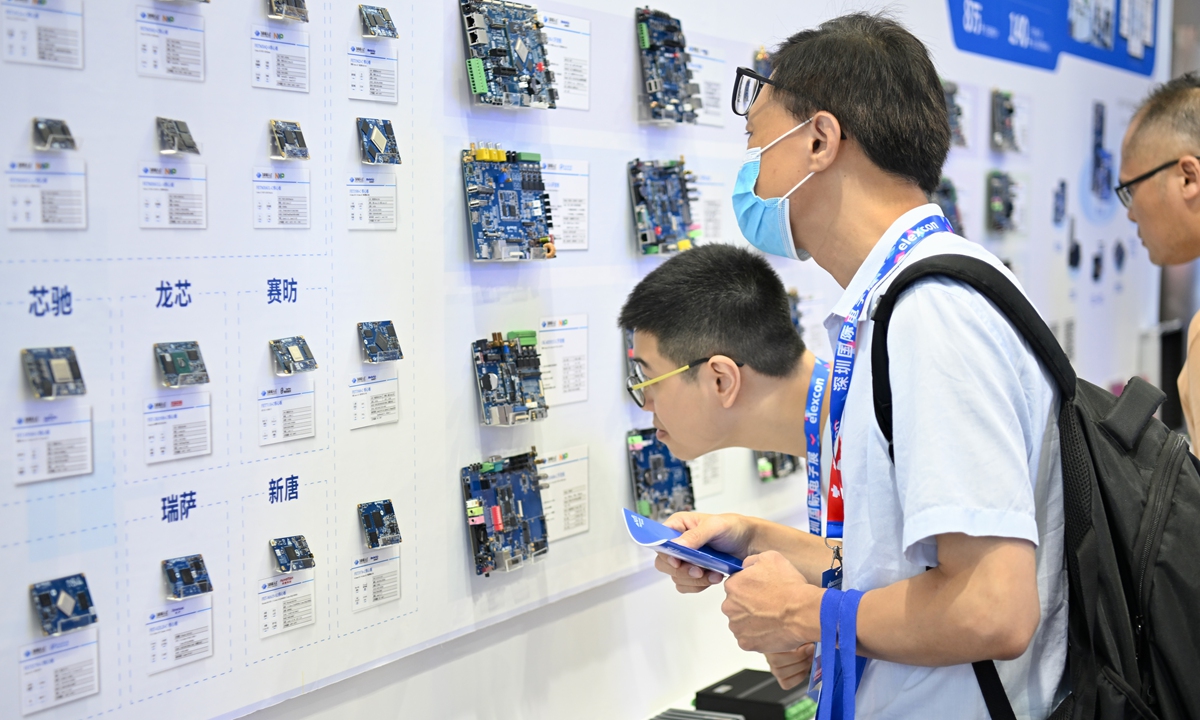
Participants explore a display of electronics components at Elexcon Shenzhen 2024 in Shenzhen, South China's Guangdong Province on August 27, 2024. More than 400 companies exhibited their leading technologies such as embedded artificial intelligence, RISC-V chip technology and intelligent sensors. Photo: VCG
Multiple Chinese manufacturing hubs have released their GDP growth figures for the first three quarters, with some showing gains of more than 5 percent. Analysts attributed the positive readings to the localities' impressive performance in manufacturing, in particular in high-tech, which they said mirrored China's ongoing industrial upgrading as well as the country's overwhelming edge in industrial manufacturing.
Observers also expect those manufacturing bases to continue serving as "pioneers and stabilizers," supporting the world's second-largest economy to embark on a stable high-quality development trajectory throughout the year. Meanwhile, a raft of incremental policies, which are set to take effect in the fourth quarter, will also inject new impetus into China's economic growth, they noted.
In the first nine months, Shenzhen, South China's Guangdong Province, known as a vibrant sci-tech and advanced manufacturing hub, reported GDP growth of 5.4 percent year-on-year, according to data released by the local bureau of statistics on Monday.
The growth was partly fueled by an uptick in manufacturing investment, which rose 35.8 percent in the first three quarters. In particular, investment in high-tech industries was up by 42.2 percent.
Other cities that also have vibrant manufacturing industries also showed impressive economic growth in the first three quarters.
For example, Yiwu in East China's Zhejiang Province, which is the global epicenter of small commodity production, saw its GDP expand 7.3 percent in the first three quarters, news website thepaper.cn reported on Friday. The value-added of high-tech manufacturing industries in Yiwu soared by 44.1 percent during the same period.
Suzhou, East China's Jiangsu Province, which is home to many domestic and foreign manufacturers, recorded GDP growth of 6 percent in the first nine months. In particular, the high-tech manufacturing sector saw an expansion of 8.8 percent year-on-year, official data showed.
Other manufacturing cities, such as Ningbo in Zhejiang Province and Qingdao in East China's Shandong Province, showed GDP growth of 5.3 percent and 5.6 percent year-on-year, respectively.
According to data released by the National Bureau of Statistics (NBS), the entire nation's GDP grew by 4.8 percent year-on-year in the first three quarters of 2024, reaching 94.97 trillion yuan ($13.33 trillion).
As industrial manufacturing plays a key role in the national economy, observers pointed out that those manufacturing hubs' brisk growth bodes well for stabilizing the fundamentals of the Chinese economy, which faces a barrage of internal and external downward pressures.
"The readings also shed light on China's industrial transformation and upgrading, as well as positive progress that has been made in the creation of new quality productive forces," Tian Yun, a veteran economist based in Beijing, told the Global Times on Monday.
Analysts expect the country's manufacturing sector to play a greater role in economic operations in the fourth quarter, further leveraging its pioneering and stabilizing role in consolidating and leading economic operations.
Yang Delong, chief economist at Shenzhen-based First Seafront Fund, told the Global Times on Monday that as the effect of a raft of incremental policies is set to bear fruit in the fourth quarter, China's economy is likely to continue its stable and sound development and stay on track to achieve the full-year GDP growth target of about 5 percent.
China's Vice Minister of Finance Liao Min said on Friday during a meeting of the World Bank that the
country is confident of achieving the target of about 5 percent GDP growth for 2024, and it will step up counter-cyclical adjustments in fiscal policy in addition to monetary policy stimulus, according to a readout on the website of the Ministry of Finance on Sunday.




